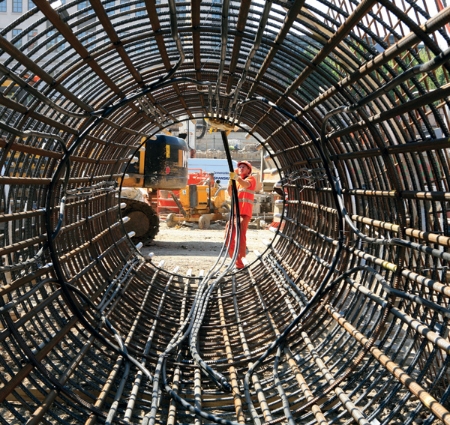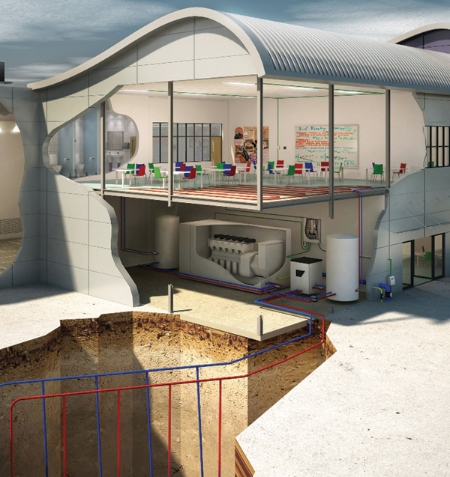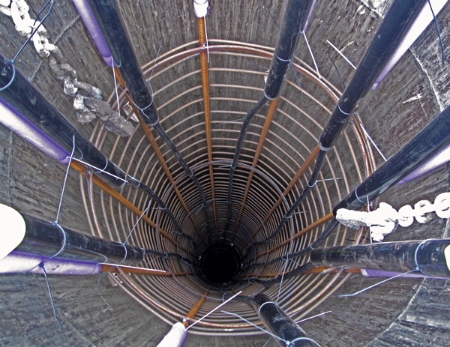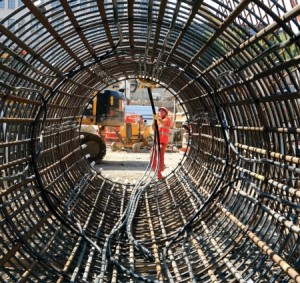Ground Source Heat Pumps (GSHPs), and their application in geothermal heat extraction, have matured as a technology in recent years. But their take-up varies widely in Europe from country to country. Climatic and geological conditions differ a great deal, and economic circumstances and traditional construction methods are wildly dissimilar.
At the recent Ground Source Live! Conference in Peterborough, UK, Philippe Dumas, manager of the European Geothermal Energy Council (EGEC), attempted to identify some of the reasons why countries such as Germany and Sweden lead the league table of developers, while those of the Baltic states, for example, lag considerably behind. Yet even in those countries that were quick to seize the initiative, the speed of further development has slowed. Heat pump sales of all types may be generally stable, but GSHP’s share is decreasing alarmingly in some parts of Europe, particularly where the market is more mature, while interest is surging in southern European Mediterranean countries, which began at a low level.
Germany is a good case in point, and a mature market where penetration for GSHP in new, single family homes had risen to almost 20 percent by 2008, with similar interest shown in countries such as Finland, Austria and Switzerland. World Geothermal Council (WGC) figures report that last year Sweden led the group of European developers with a total of 4.5 GW of installed capacity, followed by Germany (2.2 GW), and France and Switzerland (with about 1 GW each). Newer EU Member States have little capacity as yet. The industry, Dumas concluded, was seeking new incentives to push development still further forward.

Ground source heat pumps are one of the most advanced technologies available for space heating, hot water and cooling (Source: Cementation Skanska)
In his presentation Dumas observed that countries offering financial incentives such as direct grants, tax reductions, reduced or zero interest rate loans, green certificates and insurance were likely to attract rapid growth. But, he said, fossil fuel alternatives without “externalities” were still too cheap and, in many cases, receive more subsidies. Further, it remained difficult to sell the long-term payback associated with GSHP.
There are some positive indicators, however, and Dumas cited the UK’s Renewable Heat Incentive (RHI) as a promising scheme. With the first phase in force since March for non-domestic properties, the scheme will make payments to the owner of the installation quarterly over a 20-year period. Tariff levels are calculated to bridge the financial gap between the cost of conventional and renewable heating systems. Heat output is metered and the support calculated from the amount of heat used for eligible purposes, multiplied by the tariff level.
Markets and Takeup
GSHP designers and installers are winning some ground in educating a skeptical public. GSHP is one of the most advanced technologies available for space heating, hot water and cooling, because the earth itself ‘stores’ energy and is an extremely reliable and constant energy source. It creates no harmful emissions and uses a relatively small amount of electricity to drive the required pumps and/or compressors. GSHP can help cut heating bills by up to 70 percent in some cases, and installers in the UK, for example, could qualify for significant grants. Working alongside existing heating systems, GSHP can also help cut carbon emissions, potentially to zero if systems are power using, say, renewable generated electricity.
A recent report, Geothermal Heat Pumps and Direct Use by Pike Research, cited cost and lack of consumer awareness as the primary obstacles to increased adoption of geothermal heat pumps. Yet Pike suggests that direct use of geothermal energy using heat pumps is on the rise.
The potential for geothermal heat pumps is high, according to industry analyst Mackinnon Lawrence, but installations currently represent just one percent of the heating and cooling market overall. However, growing electricity demand, rising energy prices and increasing regulation around emissions and efficiency are all expected to push demand higher. In the US, analyst Global Information expects geothermal heat pump shipments to double in volume to 326,000 units annually by 2017, while Pike Research anticipates that heat pumps will represent a significant majority of the global market for geothermal direct use applications, accounting for some 84 percent of total capacity.
For example, Fort Wayne, Indiana-based WaterFurnace is currently a supplier of geothermal equipment across many of the agencies of the federal government. The company brings together high efficiency geothermal heat pumps and controls, and its ‘LoopMaster’ ground heat exchanger design and installation services is an integrated resource to help government agencies meet their energy and sustainability objectives, the company claims.
WaterFurnace is currently working with a partner, Johnson Controls, to install the Army’s first geothermal central loop application at its Fort Bragg base, located in North Carolina. This project links barrack buildings and office buildings to a central water loop which is ground coupled under an athletic field. This central loop feeds heat pumps to provide year-round HVAC comfort. Reversible chillers are supplied with water which is then heated to provide for the entire base’s significant domestic hot water needs.
The buildings in the system have different heating and cooling demand profiles, allowing for the transport of energy where it is needed. When geothermal systems are used in conjunction with PV systems, there is a significant reduction in first cost of these systems and a higher overall system efficiency, the developres report.
Heat pumps supply more energy than they consume by using a refrigeration cycle to absorb heat from the environment and raise it to a suitable level for heating buildings or providing hot water. The process can operate in a reverse cycle to provide cooling for buildings as well. Even with the electrical demands of the pump or compressor cycle, heat pumps can provide a 50 percent reduction in CO2 emissions compared to traditional technologies.
Where heat pumps are used in conjunction with combined heat and power (CHP), the electricity generated by the CHP unit drives the electric heat pump, and the building’s heating or cooling requirement is satisfied by the combined output of the CHP and the heat pump. This fusion of sustainable technologies delivers even greater efficiencies and CO2 savings, and is, for example, being used by UK company ENER-G to power and heat the Malvern Community Hospital, in central England.

Combined heat and power (CHP) systems together with ground source heat pumps can supply under-floor heating and hot water (Source: Ecovision)
ENER-G is one of a growing number of providers now benefiting from official certification for its expertise in renewable heat pump technology in line with exacting technical standards set out by the UK’s Microgeneration Certification Scheme (MCS). The company is also a keen advocate of the government’s Renewable Heat Incentive (RHI). Typically, it says, a 200-kW ground source heat pump, operating for eight hours a day (such as at a school or moderately sized business premises) will qualify for payments of 3 pence (4.5 US cents) for every kWh of useful heat generated, creating a payment of some £210,000 (US$342,000) over the 20-year duration of the tariff (based upon 350 MWh of heat produced per year).
Remaining in the UK, the Longfield Academy in Kent with places for 1150 students combines GSHPs with solar thermal technology to maximise energy efficiency. By working in tandem, these renewable technologies supply heating and hot water to the academy, together with passive underfloor cooling in the summer months. This is projected to reduce the academy’s CO2 emissions by up to 40 percent, it says.
Both technologies were supplied and installed by ENER-G as part of the sustainable design brief set out by Carillion, which is the main contractor on the project. The architect is Jestico and Whiles. The specialist science and arts academy is situated on the site of a former school. ENER-G installed 35 boreholes and completed work on the plant room to accommodate four ground source heat pumps with a combined capacity of 200 kW. The company also installed a total of 22 solar thermal vacuum tubes covering 44 m² of the academy’s flat roof.
Lee Marshall, project director for ENER-G Sustainable Technologies, says: “In the summer and spring months, any surplus solar energy not required for hot water will be diverted to the ground loop, where it can be stored to recharge the ground with heat during the colder winter months, thereby increasing the efficiency of the heat pumps. The fusion of these two renewable technologies is used widely in countries such as Germany, but is not so well developed in the UK.”
Europe’s Largest System
Europe’s largest geothermal lake loop energy system was recently completed and commissioned at King’s Mill Hospital in the Ashfield district of Nottinghamshire in Mansfield, England. The project, designed by Geothermal International, uses “Slim Jim” Geothermal Lake Plates. According to Alan Watts, of AWEB Supply in Baton Rouge, Louisiana, the project is the largest of its kind outside North America. “The hospital is now healing patients while helping to heal the environment,” he says.
The system utilises King’s Mill reservoir, a medieval millpond expanded in the 1830s that once acted as a headwater for a dozen mills along the River Maun. It is now a spectacular wildfowl sanctuary, used extensively by the public and a local sailing club. Great care was taken to lessen the environmental impact of work at the lake. The King’s Mill Reservoir Sailing Club assisted in guiding “Seaflex” floats used to carry plate installations to their locations.
The reservoir, separated from the hospital’s grounds by a major highway, acts as the heat exchange for a 5.4-MW cooling and 5-MW heating system. The manifold is across the street from the hospital, at the reservoir. “Reverse return manifolds at the reservoir accommodate seven 200-tonne Slim Jim banks using directionally bored lines to the pumping room across the street,” Watts explains. AWEB is responsible for the design, manufacture and distribution of the plates worldwide. To date it has shipped plates to more than 40 U.S. states, in addition to Canada, the UK and South Korea.

Creating an energy pile involves fitting geothermal pipework in flexible plastic loops to the pile reinforcement cages (Source: Cementation Skanska)
New buildings, of course, are not the only ones to benefit from GSHP technology. Renewable energy specialist Ecovision, known for its water source heat pump installation at Castle Howard in York, has seen owners of many more ancient buildings subsequently turning to the company for heat pump designs. A combination of ground, water and air source heat pumps coupled with solar power are now collectively radically reducing energy bills and carbon emissions nationwide, the company claims.
Ecovision has designed and installed many closed loop water source systems but Bishop’s Palace, a medieval building, posed a more complex challenge. The Palace is surrounded by a moat, and it is from here that the renewable energy is sourced for the newly constructed visitors’ centre. It was not possible to drain the loop area prior to installation. An array of ground loops were designed on loop support frames and a diver then guided the loop array into the final position before lowering it under the water. The array sits on the moat bed but is lifted by weighting blocks, which keep it in position and hold the bottoms of the loops 200 millimetres off the moat bed.
Neil Otter, Ecovision’s operations director, commented: “We have installed many closed loop water source systems using the same loop layout strategy. However, in the past we have had the luxury of a dry surface to construct them. The challenge at Bishop’s Palace was to get the loop set in exactly the right position by floating it from the launch area on the bank into the final sunken location. Calculations were made to ensure the loops, weighting blocks and frame would float into position and remain in position when filled and operational. It was a challenging part of the installation.”
The closed loop water source system comprises six 100-meter coils headed into one larger flow and return which penetrates the moat wall adjacent to the plant room. The heat pump has an output of 22 kW and can achieve a maximum flow temperature of 70ºC. Once completed, the system will supply all of the heating and hot water for the centre.
Ecovision estimates the average temperature of the moat during the heating season to be approximately 7ºC. The under-floor heating has been designed to operate effectively at the lowest possible flow temperatures. With this across the system, the average CoP [a measure of thermodynamic efficiency] of the heat pump system will be approximately 5.2. This figures suggest that the system will be about 20 percent more efficient over the course of the year when compared with an equivalent ground source heat pump system.
The return from the RHI will be in the region of £1,700 (US$2,550) per year. The alternative conventional oil system would have cost approximately £2,900 ($4,350) per year to heat the building. The heat pump will cost about £1,200 ($1,800) per year to run, giving a combined annual financial benefit £3,400 ($5,100). The project also received funding from the heritage lottery fund.
Energy Piles
Cementation Skanska is a contractor offering an innovative process which uses foundation piles to transport and store geothermal energy from the surrounding ground. Creating an energy pile is a relatively simple process involving the introduction of geothermal pipework into the pile. Each flexible plastic loop (generally one tube down and the return tube back up) is fitted to the pile reinforcement cages. Once the piles are constructed these loops are linked to further plastic pipes embedded in the concrete floors, walls or ducting within the building, leading to a heat pump in the plant room.
The system has been used at Neo Bankside, a residential development in Southwark, London, consisting of four individual multi-storey buildings ranging in height from six to 24 stories. These buildings contain a total of 197 apartments and penthouses and 1,044 m² of ground floor retail units. The site is located close to the river Thames and adjacent to the Tate Modern art gallery. Around the circumference of the development, Cementation constructed over 400 linear meters of hard firm secant wall using a continuous flight auger technique to form a single storey basement.
Out of the 176 piles used in this construction, 130 were designated energy piles and have had geothermal loops installed within. These piles contain several loops, the number of which depends on the diameter of the pile. The bigger the pile, the more geothermal capacity and hence the greater the number of loops that can be installed. The piles form an integral part of the development’s ground source heating and cooling system. In order to gain maximum output from the piles, the geothermal loops had to be installed to the full depth of the bore.

 Follow
Follow